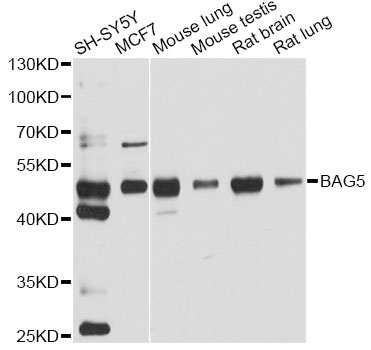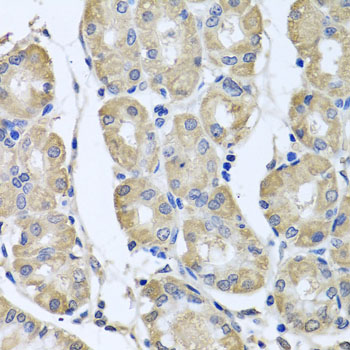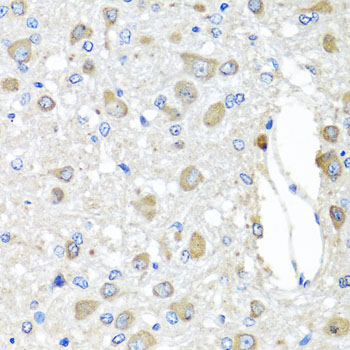Product Name :
BAG5 polyclonal antibody Background :
Bag-5 (Bcl-2-associated athanogene 5), also known as Bag family molecular chaperone regulator 5, is a member of the Bag family of proteins and contains four Bag domains. Via their Bag domain, Bag proteins bind with high affinity to the HSC 70/HSP 70 ATPase domain, regulating chaperone activity and apoptosis. Bag-5 is a component of the HSP 70/Parkin complex and acts to inhibit Parkin E3 ubiquitin ligase activity and HSP 70 chaperone activity. In this complex, Bag-5 directly interacts with the ATPase domain of HSP 70 and the N-terminal linker region of Parkin. Bag-5 expression is induced upon dopaminergic neuron injury and functions to sensitize the neurons to injuryinduced cell death. In addition, Bag-5 may be a useful target in therapies for neurodegenerative diseases such as Parkinson’s disease which is caused by a mutation in the gene encoding Parkin. Product :
Rabbit IgG, 1mg/ml in PBS with 0.02% sodium azide, 50% glycerol, pH7.2 Storage&Stability :
Store at 4°C short term. Aliquot and store at -20°C long term. Avoid freeze-thaw cycles. Specificity :
BAG5 polyclonal antibody detects endogenous levels of BAG5 protein. Immunogen :
Recombinant full length Human BAG5. Conjugate :
Unconjugated Modification :
Unmodification
BAG5 polyclonal antibody Background :
Bag-5 (Bcl-2-associated athanogene 5), also known as Bag family molecular chaperone regulator 5, is a member of the Bag family of proteins and contains four Bag domains. Via their Bag domain, Bag proteins bind with high affinity to the HSC 70/HSP 70 ATPase domain, regulating chaperone activity and apoptosis. Bag-5 is a component of the HSP 70/Parkin complex and acts to inhibit Parkin E3 ubiquitin ligase activity and HSP 70 chaperone activity. In this complex, Bag-5 directly interacts with the ATPase domain of HSP 70 and the N-terminal linker region of Parkin. Bag-5 expression is induced upon dopaminergic neuron injury and functions to sensitize the neurons to injuryinduced cell death. In addition, Bag-5 may be a useful target in therapies for neurodegenerative diseases such as Parkinson’s disease which is caused by a mutation in the gene encoding Parkin. Product :
Rabbit IgG, 1mg/ml in PBS with 0.02% sodium azide, 50% glycerol, pH7.2 Storage&Stability :
Store at 4°C short term. Aliquot and store at -20°C long term. Avoid freeze-thaw cycles. Specificity :
BAG5 polyclonal antibody detects endogenous levels of BAG5 protein. Immunogen :
Recombinant full length Human BAG5. Conjugate :
Unconjugated Modification :
Unmodification
-
 Western blot analysis of extracts of various cell lines, using BAG5 antibody.
Western blot analysis of extracts of various cell lines, using BAG5 antibody. -
 Immunohistochemistry of paraffin-embedded human stomach using BAG5 antibody.
Immunohistochemistry of paraffin-embedded human stomach using BAG5 antibody. -
 Immunohistochemistry of paraffin-embedded human stomach using BAG5 antibody.
Immunohistochemistry of paraffin-embedded human stomach using BAG5 antibody.
Bioworld Biotech only provide peptides for our antibodies and do not provide additional peptide customization services.
Price/Size :
USD 368/1mg/vial
Tips:
For phospho antibody, we provide phospho peptide(0.5mg) and non-phospho peptide(0.5mg).Describe :
Blocking peptides are peptides that bind specifically to the target antibody and block antibody binding. These peptide usually contains the epitope recognized by the antibody. Antibodies bound to the blocking peptide no longer bind to the epitope on the target protein. This mechanism is useful when non-specific binding is an issue, for example, in Western blotting (WB) and Immunohistochemistry (IHC). By comparing the staining from the blocked antibody versus the antibody alone, one can see which staining is specific; Specific binding will be absent from the western blot or IHC performed with the neutralized antibody.Formula:
Synthetic peptide was lyophilized with 100% acetonitrile and is supplied as a powder. Reconstitute with 0.1 ml DI water for a final concentration of 10 mg/ml.The purity is >90%,tested by HPLC and MS.
Storage:
The freeze-dried powder is more stable. For short time at 2-8°C. For long term storage store at -20°C.
Note :
This product is for research use only (RUO only). Not for use in diagnostic or therapeutic procedures.
 BAG5 polyclonal antibody
BAG5 polyclonal antibody  Datasheet
Datasheet COA
COA MSDS
MSDS SHIP
SHIP